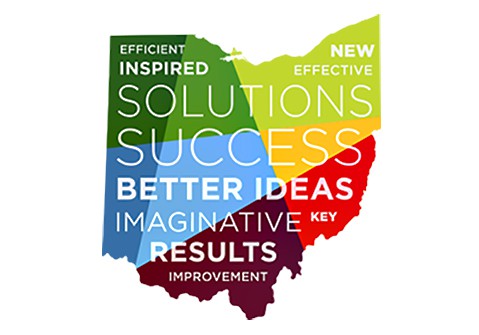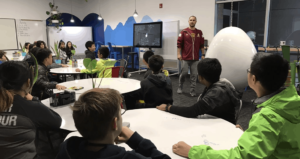Straight A Fund Seeds Ohio With Innovations

Michael Harlow
In 2013, Ohio attracted national attention with Gov. John Kasich’s push for a “Straight A Innovation Fund.” The $250,000,000 competitive grant challenge awarded 24 successful applicants in December of that year and another 36 the following June. The Ohio Department of Education recently hosted Straight A Day (#StraightADay) at the Statehouse in Columbus. 57 exhibitors showed the fruits of the innovations seeded with state dollars. I was able to visit the city, still basking in the glow of the recent college football championship won by its Ohio State Buckeyes.
After perusing the displays and talking with teachers, superintendents and students made me very optimistic that a great deal of innovation is about to unfold in Ohio. And, that the strong ecosystem to support the changes and make it easier for others to join in under less risky circumstances is taking root in Ohio.
Dayton Early College Academy. Established in 2003 with backing from KnowledgeWorks and the Bill & Melinda Gates Foundation, Dayton Early College Academy (DECA) is a premier high school in the Dayton area. With its Straight A Fund dollars, DECA will expand its offerings to include a “Smart Summer” to minimize academic challenges before the school year begins, expand its blended learning offerings, and partner with parents to offer supports including for those looking to further their own education.
Northwest Ohio: At the conference, I spoke with Lincolnview superintendent Jeffrey Snyder whose district have partnered with a consortium of rural Northwestern Ohio districts to provide enhanced online learning opportunities for 7-12 grade students. He said students who were ready to take college-level classes were reluctant to leave the high schools for local colleges and miss out on activities and connections already made. In this consortium, the college coursework is provided in high schools and allows for a broader array of classes, including technology offerings, not covered by AP.
Lake Erie Academy. Also in northwestern Ohio, Lake Erie Academy is using funds to establish a computer assisted reading instruction program. The project will be a collaborative effort with Bowling Green State University. Funding has already improved curricula and supported procurement efforts.
Battelle. A leader in commercializing scientific research, Battelle is backing an effort called College Ready Ohio. In collaboration with The Ohio State University and two Educational Service Centers, the program will expand high school students’ college readiness via mobile learning, open digital resources and College Credit Plus (Ohio’s dual-enrollment policy) opportunities. 24 Catalyst Teachers have already been trained in digital content creation and transformative teaching.
Westerville. How do teachers know which digital learning products to use? The Columbus suburb of Westerville leads a consortium for teachers to evaluate various tools and create a Consumer Reports-style comparison among products. The project is called EDCITE: Evaluating Digital Content for Instructional and Teaching Excellence. Finding the most effective (and cost-effective) learning tools will be very important as the array of products to support learning, assessment and management continues to expand.
Reynoldsburg. Another district in suburban Columbus, Reynoldsburg, which has been admitted to the League of Innovative Schools, was lead applicant in Innovation Generation. The program assembles work-related experiences for the students and helps them develop those skills. The skills are targeted along career pathways, such as: Advanced Manufacturing & Robotics, Business Logistics, Health Care, and Networking & Digital Technology.
Milford. Suburb of Cincinnati, Milford Schools partnered with Cincinnati Public Schools to develop a series of innovative business partnerships. The Straight A Fund grant will support replication and refinement of a promising case-study method that integrates technology and improved student learning in financial literacy and business development.
Mentor. Near Cleveland, Mentor Public Schools upgraded its devices and its related infrastructure over the past several years. The district is using funds to update its learning center, called The Hub, where workspaces are designed to foster collaboration in a way that the modern workforce expects. By eliminating the front of the room, they’ve seen a major boost in participation.
#TeamMentor students in the front row for @johnkasich speech for #StraightADay #OnceACard @mentorschools @mentorhigh pic.twitter.com/SVpmzAVlx9
— Matt Miller (@MentorSuper) February 5, 2015
Whether enhancing technology, academic rigor, or both, applicants were also required to show how their plans would result in cost savings. Cost savings can be found from reducing textbook and copy paper purchases. Some districts save on facility costs by making existing spaces more useful and increasing the efficiency of the building. Other schools save dollars by sharing instructional costs for new classes across district boundaries. Delivering better, more relevant instruction that saves taxpayer dollars in the process? It sounds to me like the state of Ohio is on its way to becoming a national champion in a far more meaningful endeavor.






Bill Hulsizer
Where do they advertise this grant progam? We sure didn't hear about it.
Bill Hulsizer, Director
Big Joe Duskin Music Education Foundation
www.BigJoeDuskin.org